I'll add this as an answer, rather than a comment to the OP and all of the answers.
You cannot transmit over a significant distance with a magnetic field.
There are two types of extreme situation that occur when using antennae to communicate with each other.
a) you have a predominantly dipole electric field, for instance a pair of seperated plates. This can be detected electrostatically nearby as a high impedance near field, that falls off as the cube of the distance, and doesn't propogate any power unless intercepted by a reciever. Further away, the electromagnetic 377ohm impedance far field wave that falls off as the square becomes the only signal detectable.
b) you have a predominantly dipole magnetic field, for instance a coil of wire. This can be detected magnetically nearby as a low impedance near field, that falls off as the cube of the distance, and further away as a 377ohm impedance far field electromagnetic wave that falls off as the square.
A long range transmitting antenna will be designed so that neither of these extremes are excited, as both will be inefficient, and will ideally launch a propagating electromagnetic wave. The non-propagating near field merely increases voltages or currents in the antenna which increase losses or limit the maximum power that can be used. Near-field magnetic chargers for cars and phones are intentionally short range and non-propagating in the far field.
The difference between near and far field has to do with the aperture of the antenna, and frequency of the signal. In the case of a sub the size of a person, once you are more than a person's length or two away, very little of the magnetic near field remains to be detected, and the only signal that is receivable will be the electromagnetic far field, that will be strongly attenuated by the water, with a frequency dependence, and a water conductivity dependence.

